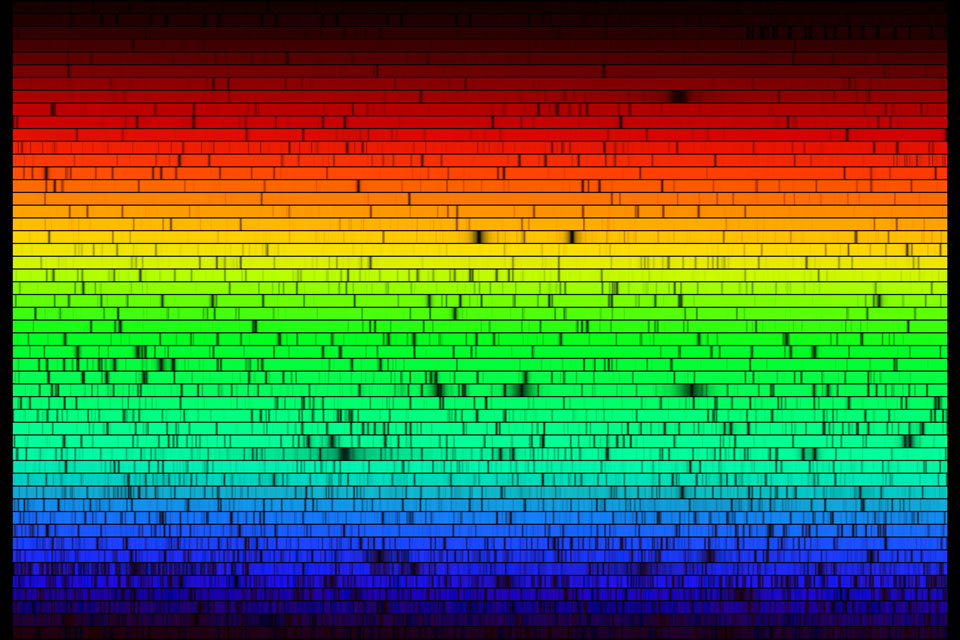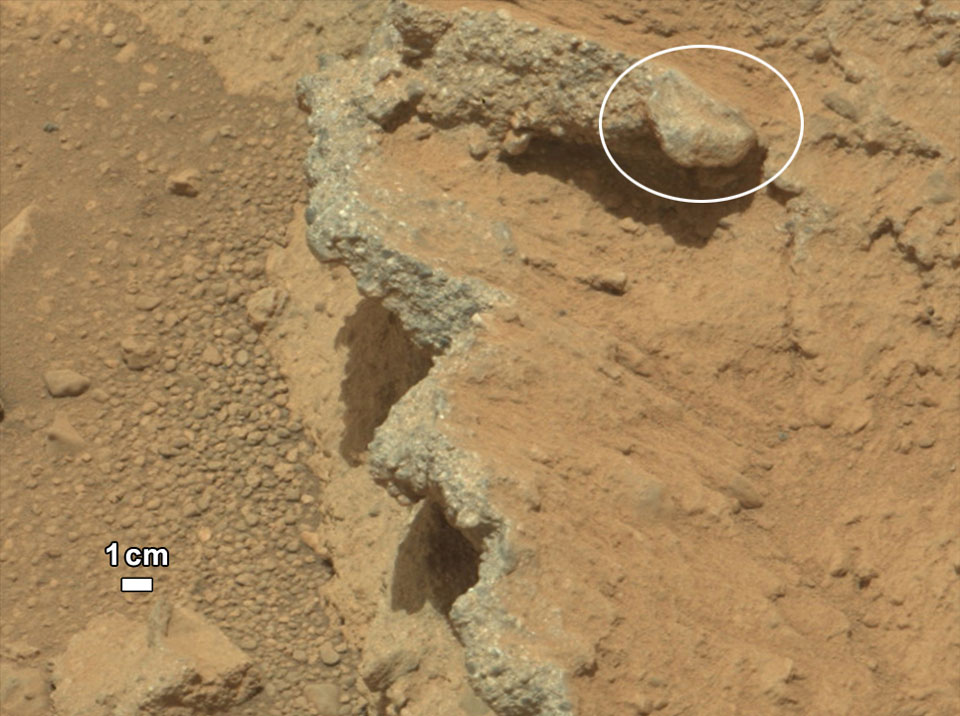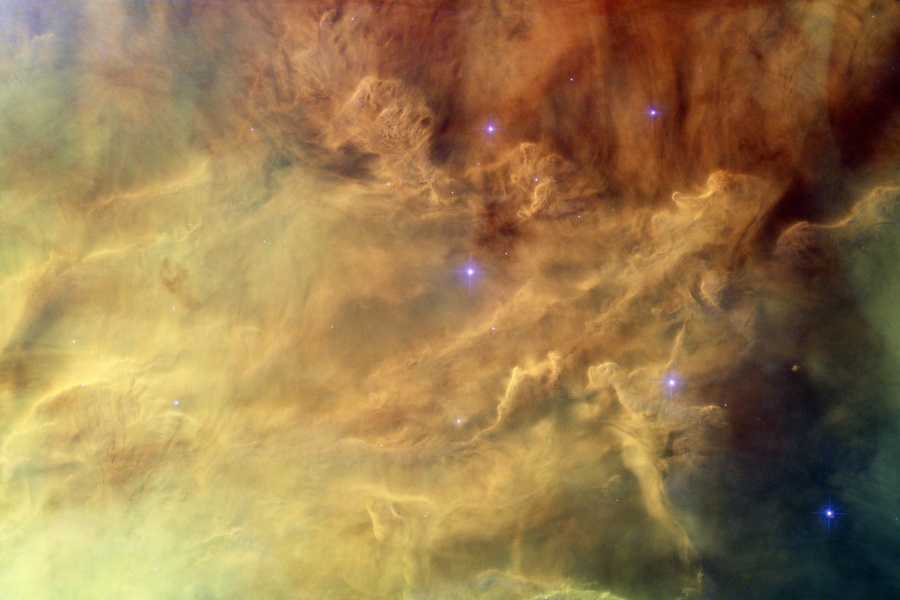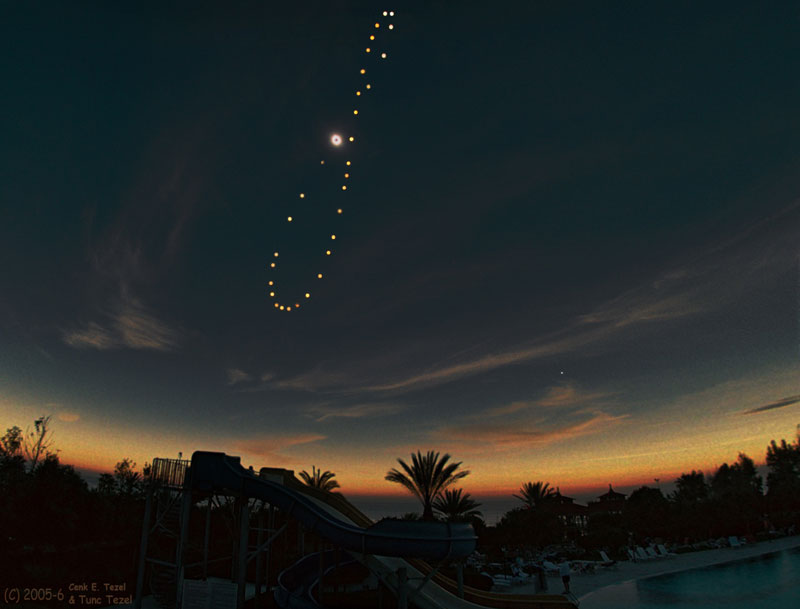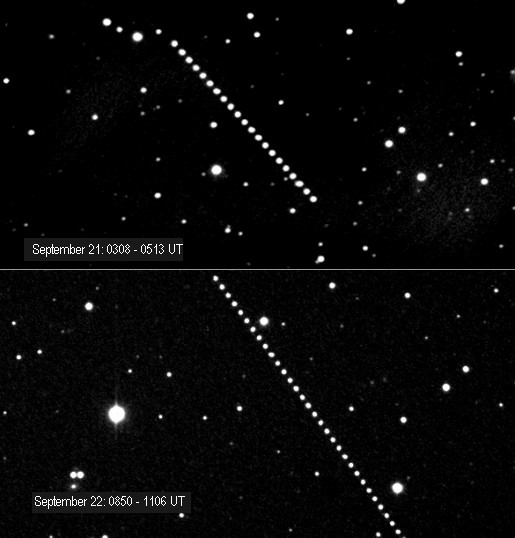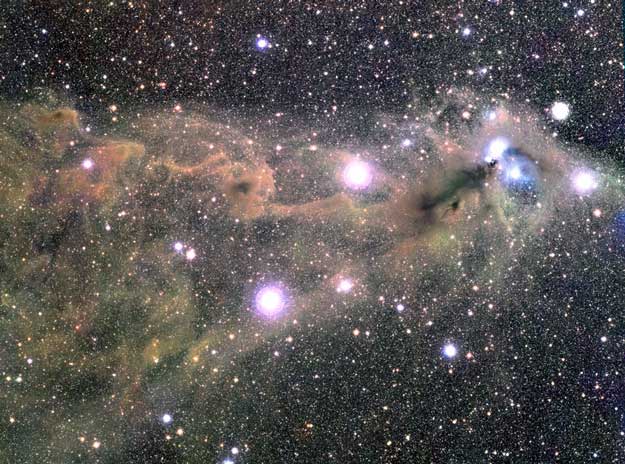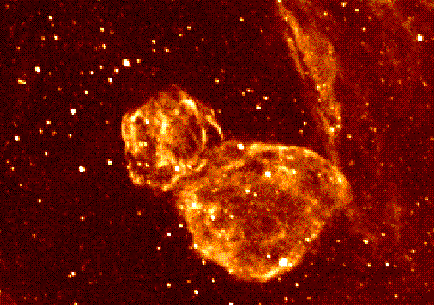[table][tr][td=left]<< Previous[/td][td=center]Index[/td][td=right]Next >>[/td][/tr][/table][/b]
2014 Blown by the wind from a massive star, this interstellar apparition has a surprisingly familiar shape. Cataloged as NGC 7635, it is also known simply as The Bubble Nebula. Although it looks delicate, the 10 light-year diameter bubble offers evidence of violent processes at work. Below and left of the Bubble's center is a hot, O star, several hundred thousand times more luminous and around 45 times more massive than the Sun. A fierce stellar wind and intense radiation from that star has blasted out the structure of glowing gas against denser material in a surrounding molecular cloud. The intriguing Bubble Nebula and associated cloud complex lie a mere 11,000 light-years away toward the boastful constellation Cassiopeia. This tantalizing view of the cosmic bubble is composed from narrowband image data, recording emission from the region's ionized hydrogen and oxygen atoms. To create the three color image, hydrogen and oxygen emission were used for red and blue and combined to create the green channel.
2013 It is still not known why the Sun's light is missing some colors. Here are all the visible colors of the Sun, produced by passing the Sun's light through a prism-like device. The spectrum was created at the McMath-Pierce Solar Observatory and shows, first off, that although our white-appearing Sun emits light of nearly every color, it does indeed appear brightest in yellow-green light. The dark patches in the above spectrum arise from gas at or above the Sun's surface absorbing sunlight emitted below. Since different types of gas absorb different colors of light, it is possible to determine what gasses compose the Sun. Helium, for example, was first discovered in 1870 on a solar spectrum and only later found here on Earth. Today, the majority of spectral absorption lines have been identified - but not all.
2012 Fresh evidence of an ancient stream has been found on Mars. The robotic rover Curiosity has run across unusual surface features that carry a strong resemblance to stream banks on Earth. Visible in the above image, for example, is a small overhanging rock ledge that was quite possibly created by water erosion beneath. The texture of the ledge appears to be a sedimentary conglomerate, the dried remains of many smaller rocks stuck together. Beneath the ledge are numerous small pebbles, possibly made smooth by tumbling in and around the once-flowing stream. Pebbles in the streambed likely fell there as the bank eroded. Circled at the upper right is a larger rock possibly also made smooth by stream erosion. Curiosity has now discovered several indications of dried streambeds on Mars on its way to its present location where it will be exploring the unusual conjunction of three different types of landscape.
2011 Yes, but can your meteor do this? The most powerful natural explosion in recent Earth history occurred on 1908 June 30 when a meteor exploded above the Tunguska River in Siberia, Russia. Detonating with an estimated power 1,000 times greater than the atomic bomb dropped over Hiroshima, the Tunguska event leveled trees over 40 kilometers away and shook the ground in a tremendous earthquake. Eyewitness reports are astounding. The above picture was taken by a Russian expedition to the Tunguska site almost 20 years after the event, finding trees littering the ground like toothpicks. Estimates of the meteor's size range from 60 meters to over 1000 meters in diameter. Recent evidence suggests that nearby Lake Cheko may even have been created by the impact. Although a meteor the size of the Tunguska can level a city, metropolitan areas take up such a small fraction of the Earth's surface that a direct impact on one is relatively unlikely. More likely is an impact in the water near a city that creates a dangerous tsunami. One focus of modern astronomy is to find Solar System objects capable of creating such devastation well before they impact the Earth.
2010 Like brush strokes on a canvas, ridges of color seem to flow across this scene. But here, the canvas is nearly 3 light-years wide and the colors map emission from ionized gas in the Lagoon Nebula, recorded by the Hubble Space Telescope's Advanced Camera for Surveys. Also known as M8, the nebula is a star forming region about 5,000 light-years distant in the constellation Sagittarius. Hubble's remarkably sharp, close-up view reveals undulating shapes sculpted by the energetic light and winds from the region's new born stars. Of course, the Lagoon nebula is a popular target for earthbound skygazers, too. It features a prominent dust lane and bright hourglass shape in small telescopes with wider fields of view.
2009 These colorful panels both feature a familiar astronomical sight: the stellar nursery known as the Great Orion Nebula. They also offer an intriguing and unfamiliar detail of the nebula rich skyscape -- a passing comet. Recorded this weekend with a remotely operated telescope in New Mexico, the right hand image was taken on September 26 and the left on September 27. Comet 217P Linear sports an extended greenish tail and lies above the bluish Running Man reflection nebula near the top of both frames. Nearby and moving rapidly through the night sky, the comet's position clearly shifts against the cosmic nebulae and background stars from one night to the next. In fact, the comet was a mere 5 light-minutes away on September 27, compared to 1,500 light-years for the Orion Nebula. Much too faint to be seen with the unaided eye, Comet 217P Linear is a small periodic comet with an orbital period of about 8 years. At its most distant point from the Sun, the comet's orbit is calculated to reach beyond the orbit of Jupiter At its closest point to the Sun, the comet still lies just beyond the orbit of planet Earth.
2008
2007 If you went outside at exactly the same time every day and took a picture that included the Sun, how would the Sun appear to move? With great planning and effort, such a series of images can be taken. The figure-8 path the Sun follows over the course of a year is called an analemma. With even greater planning and effort, the series can include a total eclipse of the Sun as one of the images. Pictured is such a total solar eclipse analemma or Tutulemma - a term coined by the photographers based on the Turkish word for eclipse. The composite image sequence was recorded from Turkey starting in 2005. The base image for the sequence is from the total phase of a solar eclipse as viewed from Side, Turkey on 2006 March 29. Venus was also visible during totality, toward the lower right.
2006
2005 Mt. Etna erupted spectacularly in 2001 June. Pictured above, the volcano was photographed expelling bubbles of hot magma, some of which measured over one meter across. One reason planetary geologists study Earth's Mt. Etna is because of its likely similarity to volcanoes on Mars. Mt. Etna, a basalt volcano, is composed of material similar to Mars, and produces similar lava channels. Located in Sicily, Italy, Mt. Etna is not only one of the most active volcanoes on Earth, it is one of the largest, measuring over 50 kilometers at its base and rising nearly 3 kilometers high.
2004 On Wednesday, September 29, asteroid Toutatis came within one million miles of Earth -- the closest predicted aproach of a sizable asteroid or comet to our fair planet in this century. Coming within one million miles or about 4 times the Earth-Moon distance, Earth would have appeared to be nearly the size of the full moon in the asteroid's sky. In Earth's sky, Toutatis appeared only as a faint, starlike, but rapidly moving object. Even so, asteroid 4179 Toutatis was still bright enough to see in small telescopes. Astronomers John Chumack, observing near Dayton Ohio, and Juergen Wolf from near Palo Alto, California, offer these composite images showing the progress of the asteroid (seen as a series of dots) against a background of distant stars. Their multiple exposures span a two hour period on two different days about a week before the asteroid's record close approach, which tracked through night skies south of the celestial equator.
2003 The 1970s are often overlooked. In particular, the beautiful grouping of reflection nebulae NGC 1977, NGC 1975, and NGC 1973 in Orion are often overlooked in favor of the substantial stellar nursery better known as the Orion Nebula. Found along the sword of Orion just north of the bright Orion Nebula complex, these nebulae are also associated with Orion's giant molecular cloud which lies about 1,500 light-years away, but are dominated by the characteristic blue color of interstellar dust reflecting light from hot young stars. In this sharp color image a portion of the Orion Nebula appears along the bottom border with the cluster of reflection nebulae at picture center. NGC 1977 stretches across the field just below center, separated from NGC 1973 (above right) and NGC 1975 (above left) by dark regions laced with faint red emission from hydrogen atoms. Taken together, the dark regions suggest to many the shape of a running man.
2002 The flowing trails of dust toward Corona Australis, the constellation of the Southern Crown, are visible here not because they glow, but because they absorb and reflect. The dust appears bluer when seen near bright stars because it preferentially reflects blue light. The densest knots of dust are so thick that no background stars or interior stars can be seen through them. These knots indicate molecular clouds filled with cool gas where future stars will likely form. The above image spans about 5 degrees while the reflection nebula lies about 500 light-years distant.
2001 What would it be like to fly free over the seas and clouds of Earth? In 1994 astronaut Mark Lee found out when he tested the Simplified Aid for EVA Rescue (SAFER) system for NASA. SAFER is a backpack propulsion unit that incorporates small nitrogen thrusters controlled by hand and moderated by computer. Pictured, Lee jets about the bay of Space Shuttle Discovery, over 200 kilometers above Earth in the first untethered space walk in ten years. Lee was not in danger -- the shuttle could have been used to retrieve him. SAFER, smaller than the Manned Maneuvering Unit, is designed as a backup system to help astronauts in the unlikely event that they become too separated from their work outside the International Space Station.
2000 Is this what will become of the Earth's surface? The surface of the Earth is broken up into several large plates that are slowly shifting. About 250 million years ago, the plates on which the present-day continents rest were positioned quite differently, so that all the landmasses were clustered together in one supercontinent now dubbed Pangea. About 250 million years from now, the plates are again projected to reposition themselves so that a single landmass dominates. The above simulation from the PALEAOMAP Project shows this giant landmass: Pangea Ultima. At that time, the Atlantic Ocean will be just a distant memory, and whatever beings inhabit Earth will be able to walk from North America to Africa.
1999 It's clear who is the biggest star in this binary system. Based on recent results, this artist's vision of the double star Phi Persei, 720 light years away, shows a bright, rapidly rotating massive star surrounded by a disk of gas. A small companion star orbits 100 million miles away. The bigger star is presently about 9 times more massive than the small one ... but it wasn't always this way. Ten million years ago the small companion was actually the most massive star in the system and because of its greater mass evolved into a giant star more quickly. After losing its swollen outer layers to the now massive star, all that remains is a stripped down, intensely hot core of about 1 solar mass. In another ten million years, the roles may reverse as the now massive star swells into its own giant phase "returning" mass to its companion. Will these stars end their lives as white dwarfs or supernovae? Astronomers consider the ultimate fate of such mass-exchanging, interacting binary systems an open question and a challenge for present theories of stellar evolution.
1998 Indicated on this infrared image of the galactic center region is the position of SGR 1900+14 - the strongest known magnet in the galaxy. SGR 1900+14 is believed to be a city-sized, spinning, super-magnetic neutron star, or Magnetar. How strong is a Magnetar's magnetic field? The Earth's magnetic field which deflects compass needles is measured to be about 1 Gauss, the strongest fields sustainable in Earth-based laboratories are about 100,000 Gauss, yet the Magnetar's monster magnetic field is estimated to be 1,000,000,000,000,000 Gauss. A magnet this strong, located at about half the distance to the Moon would easily erase your credit cards and suck pens out of your pocket. From a distance of about 20,000 light-years, SGR 1900+14 recently generated a powerful flash of gamma-rays detected by many spacecraft. That blast of high-energy radiation is now known to have had a measurable effect on Earth's ionosphere. At the surface of the Magnetar, its powerful magnetic field is thought to buckle and shift the neutron star crust generating the intense gamma-ray flares.
1997 When a massive star exhausts its nuclear fuel it explodes. This stellar detonation, a supernova, propels vast amounts of starstuff outwards, initially at millions of miles per hour. For another 100,000 years or so the expanding supernova remnant gradually slows as it sweeps up material and ultimately merges with the gas and dust of interstellar space. Short lived by cosmic standards, these stellar debris clouds are relatively rare and valuable objects for astronomers exploring the life cycles of stars. Yet this double bubble-shaped nebula 160,000 light-years away in the Large Magellanic Cloud may represent something rarer still - the collision of two supernova remnants. This image in the light of excited Hydrogen atoms along with images at X-Ray, radio and other optical wavelengths, suggests that the bubbles are indeed two separate regions of hot gas surrounded by cooler dense shells begining to interact as they expand and make contact.
1996
1995 Mars, the red planet named for the Roman god of war, has two tiny moons, Phobos and Deimos, whose names are derived from the Greek for Fear and Panic. These Martian moons may well be captured asteroids originating in the asteroid belt between Mars and Jupiter or perhaps from even more distant reaches of the Solar System. In this 1977 Viking orbiter image, the largest moon, Phobos, is seen to be a heavily cratered asteroid-like object. It is about 17 miles across and zips through the Martian sky completing an orbit in less than 8 hours. Phobos is doomed. It orbits so close to Mars, (about 3,600 miles above the surface compared to 250,000 miles for our Moon) that gravitational tidal forces are dragging it down. In 100 million years or so it could crash into the surface or be shattered by stress caused by the relentless tidal forces, the debris forming a ring around Mars.
| << Previous | Index | Next >> |

